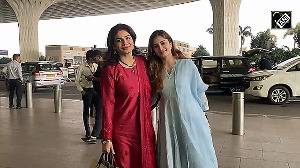Time for a memory check. Which was the last domestic airlines' TV commercial that you saw? The 150-second long Air Deccan ad? That's what a thoroughly unscientific straw poll confirms as the best recalled. But which else?
It's peculiar. The aviation sector is going helter skelter. Out-of-home (OOH) signposts and print ad-spreads abound. But how come so little of the advertising is on television?
"IndiGo is not currently advertising on TV," says Bruce Ashby, CEO, IndiGo, "However, this is because we only have a few routes at this time, and we see TV as a better medium for reaching a national audience. As we grow over the next year, we will be reviewing TV, and I wouldn't be a bit surprised if we moved into that medium."
IndiGo seems to have a valid point. But what about Spicejet, Kingfisher, Air Deccan and Jet Airways? After all, they have been around for quite some time.
"It is not about neglecting TV or anything," says John Kuruvilla, chief revenue officer, Deccan Aviation, "but we feel that when there is a need for a TV campaign, we will certainly go ahead with it." In the interim, he adds, print is better suited to the sort of messages that need to be conveyed.
Sanjay Kumar, vice-president, sales and planning, SpiceJet, agrees with Kuruvilla. "With TV, you have to come up with a campaign which communicates on a national level," he says, "while most of our communication is somewhat local, so print is preferred." SpiceJet hasn't had a single TVC so far.
While Air Deccan has started to use radio as a medium, SpiceJet seems to play the waiting game on radio. SpiceJet spent around Rs 10 crore (Rs 100 million) on advertising in 2005, and Kumar says that it will go up by 50 per cent for 2006.
Advertising executives endorse the airlines' stance on choice of media.
Jayshree Sunder, executive vice-president, Leo Burnett, for example, says that it's a question of what is appropriate to the task. "Airlines want to communicate fares, route changes or midnight flights - and print is more suited to those kind of messages."
Also, TV channels ask for at least a week's lead time before assuring a slot, which could prove irksome, given the hour-to-hour dynamics of aviation planning.
But that still doesn't explain the shift. And "shift", it is, too. Figures from Adex, an ad volume measurement tool, indicate that domestic airlines have been switching from TV to print over the past couple of years.
Some 80 per cent of the ad spend for the category is on print now, the rest being scattered across radio, OOH (mostly hoardings and bus signs) and other such vehicles.
Well, maybe advertisers have taken that old Hollywood line to heart: "If you don't read, you aint goin' nowhere, kid."







 © 2025
© 2025